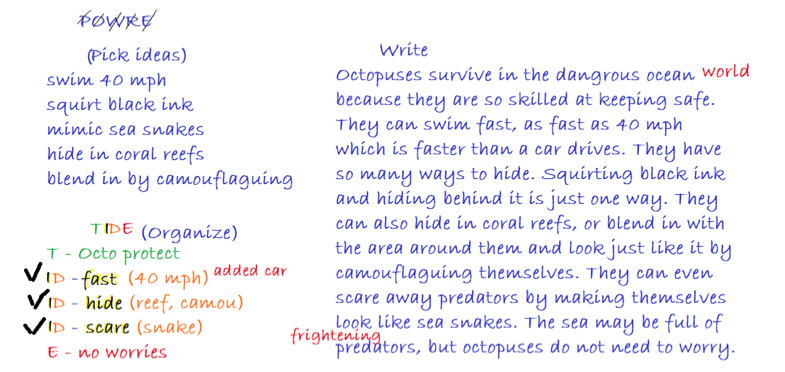
“Science was my favorite subject, but now it’s writing”, a teacher recently overheard. In contrast, many frustrated children often struggle to generate and draft their ideas. Thanks to decades of research, we now have inroads that transform writing quality, and attitudes, as this teacher discovered. How can parents follow these inroads?
#1: During bedtime reading, develop a ‘writer’s eye’. When reading favorite books at bedtime, do a second re-read to discover how authors present their ideas. Point out how authors make careful decisions when they choose rich words or how to organize what they write. Note that we can become better writers ourselves by paying closer attention to these decisions authors made.
#2: Start with structure. Help your child discover how authors organized their writing. In informational books (non-fiction), look for and note: catchy topic introductions, interesting details, and an end. Stories (fiction) follow a structure that includes a beginning (B) that tells who, when and where, then a middle (M) that includes what’s the main character’s goal and what happens, and an end (E) that show how the story ends and how the character feels at the end. Great writing then comes from noticing and mimicking the rich choices authors make. Point out feature such as hooking your readers with a fun opening, fascinating facts, rich description, transitions, vocabulary and conveying passion. Also read pieces written by other kids so your children can relate, and construct a vision that they too can be writers. Find such samples by typing “children’s writing samples” into any search engine.
#3: Write together. Use brightly colored lined sketch pads and markers or fun pencils for writing sessions. Explain the ideas from the books you just read are so exciting that you want to journal about them. Explain that when we write, we can use a helpful writing process: pick ideas, organize them, write drafts, then revise and edit those (POWRE). POWRE is a tool to help us follow the full writing process whenever we write, such as a thank you note or about a trip, and can move on to longer and more diverse writing, such as a report. First, we pick (P) our ideas which might mean we list what we liked about the gift, a trip, or the books we just read. We might also pick (P) a list of words we would like to use in our writing. Next, we decide how to organize (O) our ideas, then write (W) a draft, and finally reread it for revisions (R) or edits (E) needed. Parents can scribe for children at this point. The example below illustrates writing about a fascination about octopuses. After reading several books about them, you can scribe as your child dictates. Demonstrate using POWRE to guide your child in using the full writing process to write about a favorite topic

Turn your draft into a ‘book’ (you still scribing) over several pages, with illustrations. As motivation, “publish” and read this ‘book’ to a real audience (i.e. a relative) or post it as a blog. For now, keep mechanical aspects of writing at bay by scribing your child’s story. Issues such as spelling or grammar should be taught, but not at the entry point.
#4: Teach and model how writers cope. As you write together, model coping so your child develops an inner voice to direct oneself when writing gets difficult (it will!). For instance, if your child is anxious, say, “I just want it done. What can I say to slow myself down and give my best effort?” Model self- encouraging statements such as “I can do it – one step at a time” or “I’ll look at more books for ideas”. As you use these statements, let your child watch how you get unstuck when writing. Also, write these on the sketch pad in a list, then turn to this list whenever you want to model and practice coping. Remind your child to use this list of positive self-statements like this to get “unstuck’” all day long!
#5 Self-evaluate. To help your child self-evaluate their writing, score your scribed writing, giving one point for each part of TIDE (topic, 3 important details, end) or if you wrote a story, for each part in Beginning, Middle, and End. See thinkSRSD.com for sample grade level student writing and scales for scoring writing. You can also turn the scoring over to your child to see if you both agree on the score.
Just as we improve at sports with drills or music by playing scales, writing improves when we practice, set goals (i.e. better word choice), and self-evaluate our progress toward our goals. Encourage your child to keep reading and set new, higher goals for writing. Your children are in charge! They will decide what books to read, and about what topics to journal and write. Children can identify themselves as writers, and enjoy the process.
Proper citation link for this blog post:Laud, L. & Patel, P. (June 15, 2018). Help Your Children Become Expert Joyful Writers. Retrieved from https://infoaboutkids.org/blog/help-your-children-become-joyful-expert-writers.
















